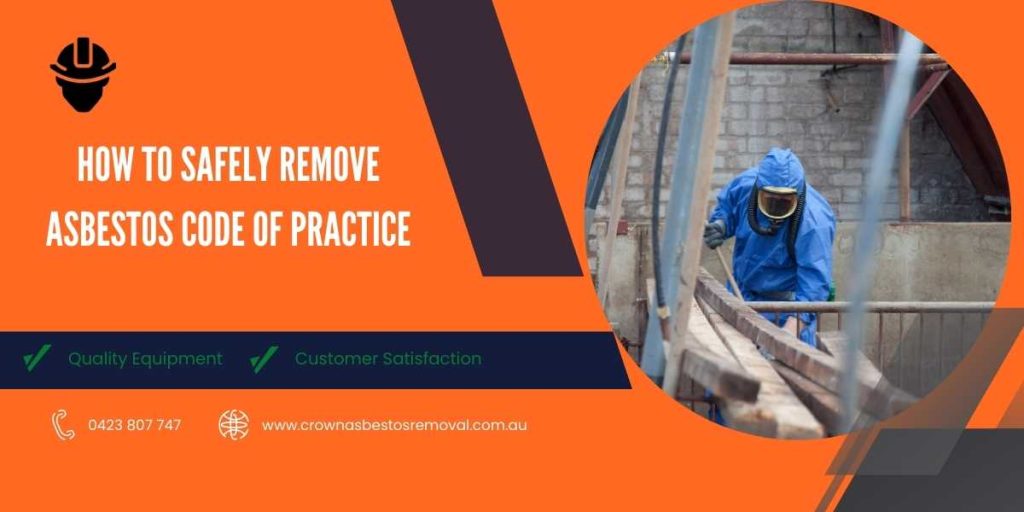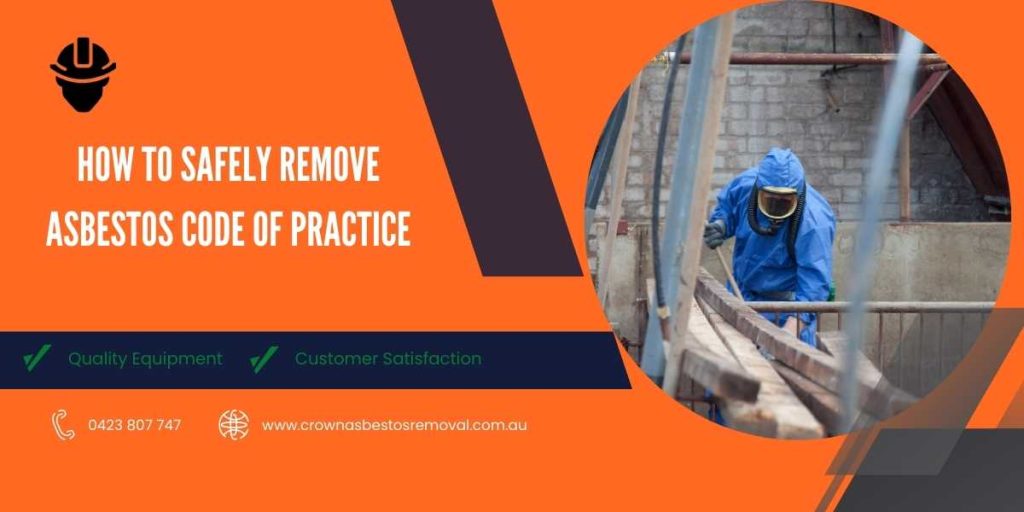How to safely remove asbestos Code of Practice
Introduction

Asbestos is a hazardous material that poses serious health risks when disturbed. Ensuring safe removal is critical to protecting workers and the community. This article outlines the Code of Practice for safely removing asbestos, detailing procedures, responsibilities, and essential information.
Overview of Asbestos and Its Risks
Asbestos is a group of naturally occurring minerals widely used in building materials for its strength and heat resistance. However, when asbestos fibers are released into the air, they can be inhaled, leading to severe health issues such as lung cancer, asbestosis, and mesothelioma.
Purpose of the Code of Practice
The Code of Practice for asbestos removal provides guidelines to ensure safety during asbestos removal. It aims to protect workers and the public, promoting compliance with legal and regulatory requirements.
Understanding Asbestos in the Workplace
Types of Asbestos
- Friable Asbestos: This type can easily crumble and release fibers into the air, requiring stringent removal measures.
- Non-Friable Asbestos: This type is bonded within a solid material and poses a lower risk when left undisturbed.There are two main types of asbestos:
Where Asbestos Can Be Found
Asbestos can be found in various building materials, including insulation, roofing, ceiling tiles, and flooring materials. It is essential to conduct thorough assessments to identify any asbestos-containing materials (ACMs).
Who Needs to Follow the Code?
The Code of Practice applies to employers, contractors, and workers involved in asbestos removal. Those responsible for buildings must ensure compliance with the regulations outlined in the Code.
Preparation for Asbestos Removal
Assessment and Identification
Before any removal work begins, a comprehensive asbestos risk assessment must be conducted. This assessment identifies ACMs and evaluates the risks associated with their presence.
Developing an Asbestos Removal Plan
A detailed asbestos removal plan should be developed, outlining the procedures and safety measures to be implemented during the removal process. This plan should include risk management strategies and emergency procedures.
Licensing and Legal Requirements
Engaging licensed professionals for asbestos removal is crucial. Class A licenses are required for removing friable asbestos, while Class B licenses are necessary for non-friable asbestos. Familiarity with relevant legislation and regulatory bodies is essential for compliance.
Safe Removal Procedures
Personal Protective Equipment (PPE)
Workers involved in asbestos removal must wear appropriate personal protective equipment (PPE), including:
- P2 or higher-grade respiratory masks
- Disposable coveralls
- Gloves and protective footwear
All PPE should be disposed of properly after use to prevent contamination.
Control Measures for Asbestos Removal
To minimize exposure, control measures should be implemented during removal:
- Wet removal techniques can help prevent fibers from becoming airborne.
- Negative air pressure enclosures should be used to contain any released fibers.
- Decontamination procedures must be established for tools and equipment.
Air Monitoring and Clearance Inspections
Regular air monitoring during the removal process is essential to ensure that asbestos fibers are not present in the air. After removal, a clearance inspection must confirm that the area is safe for reoccupation.
Waste Management and Disposal
Handling and Packaging of Asbestos Waste
Asbestos waste must be handled and packaged safely:
- Sealed in double-layered, heavy-duty plastic bags.
- Clearly labeled to indicate the presence of asbestos.
Transport and Disposal Regulations
Asbestos waste must be transported to an approved asbestos disposal facility. It is illegal to dispose of asbestos waste in general landfill sites, and all disposal must comply with local regulations.
Emergency Procedures
Dealing with Accidental Asbestos Exposure
In the event of accidental asbestos exposure:
- Immediately evacuate the area.
- Seal off the affected zone to prevent further exposure.
- Report the incident to the site supervisor and engage a licensed professional for decontamination.
- Ensure that workers receive proper medical evaluations if exposure occurred.
First Aid and Medical Surveillance
Regular medical check-ups and health surveillance programs are essential for workers who may have been exposed to asbestos. Monitoring ensures early detection of potential health issues.
Training and Competency Requirements
Asbestos Awareness Training
Workers involved in asbestos removal must complete asbestos awareness training. This training educates them about the risks associated with asbestos and the necessary precautions to take.
Training for Licensed Asbestos Removal Workers
Licensed workers must possess specific qualifications:
- A Class A License for friable asbestos removal.
- A Class B License for non-friable asbestos removal.
Supervision and Safety Leadership
Having a competent supervisor on-site during removal projects is critical to ensure adherence to safety procedures and effective management of the removal process.
Compliance and Monitoring
Record Keeping
Keeping detailed records of asbestos assessments, removal plans, air monitoring results, and waste disposal is vital for compliance. This documentation serves as proof of adherence to safety regulations.
Regular Audits and Inspections
Conducting regular audits and inspections helps ensure ongoing compliance with the Code of Practice. Any non-compliance must be addressed promptly to mitigate risks.
Appendices
Glossary of Terms
- Asbestos: A group of minerals used in building materials for durability and heat resistance.
- PPE: Personal Protective Equipment used to protect workers from hazards.
Friable Asbestos: Asbestos that can easily crumble and release fibers into the air.
Relevant Legislation and Guidelines
- Health and safetLocal asbestos regulations
- Health and safety guidelines
FAQs: How to Safely Remove Asbestos - Code of Practice
What is asbestos and why is it dangerous?
Asbestos is a group of naturally occurring minerals used in construction materials. When disturbed, asbestos fibers can be inhaled, leading to serious health issues such as lung cancer and asbestosis.
Who is responsible for ensuring asbestos is removed safely?
Asbestos is a group of naturally occurring minerals used in construction materials. When disturbed, asbestos fibers can be inhaled, leading to serious health issues such as lung cancer and asbestosis.
What types of asbestos require special removal procedures?
Friable asbestos, which can easily crumble, requires more stringent safety measures compared to non-friable asbestos.
Conclusion
Importance of Safe Asbestos Removal
Safe asbestos removal is crucial for protecting the health of workers and the surrounding community. By following the guidelines set forth in the Code of Practice, organizations can minimize risks associated with asbestos exposure.
Ongoing Responsibilities
Continued education and monitoring are essential for maintaining compliance with asbestos safety regulations. Organizations must remain vigilant in their efforts to protect workers and the community.
